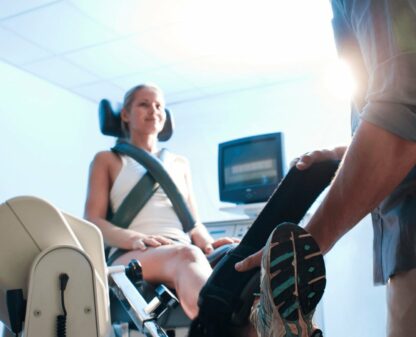ACL Tear with Meniscus or Cartilage injury Causes Worse Prognosis

Introduction
Not many SRs have investigated prognostic factors for long-term patient-reported outcome measures (PROM) and physical activity levels. Moreover, since often no methodological quality or risk of bias assessments are incorporated they are mostly of poor quality. Until now the focus was on patients after anterior cruciate ligament reconstruction (ACLR) and prognostic factors in patients treated with rehabilitation alone remain unknown. Hence the authors assessed prognostic factors for PROMs and physical activity in patients post ACL injury or ACLR and differences in prognostic factors between people treated with ACLR and those who received rehabilitation alone.
Methods
A systematic review included prospective cohorts and randomized clinical trials (RCTs) reporting on prognostic factors for PROMs or physical activity in ACL ruptured adults and adolescents (>13y) undergoing ACLR or rehabilitation. Follow-up outcome assessment ranged between 2 and 10 years.
Eligible PROMs included the IKDC-SKF, the KOS-ADLS, and the KOOS (with subscales: pain, other symptoms, function in daily living (ADL), function in sport and recreation (S/R), and knee-related quality of life (QoL)). All measurements reflecting type and level of physical activity were eligible.
Results
- Prognostic factors for PROMs in patients treated with ACLR
Moderate quality evidence: concomitant meniscus injuries were predictive for two-year patient-reported ACLR failure and worse five- and six-year KOOS S/R and QoL. A mean difference of 10-14.4 points for KOOS S/R and 8.9 points for KOOS QoL was seen between those with and without concomitant meniscus injury.
Moderate quality evidence: concomitant cartilage lesions (particularly full-thickness lesions) were prognostic for five-year KOOS (all subscales). A mean difference of 8.1 points for KOOS S/R and 8-2.3 points for KOOS QoL was observed between those with and without concomitant cartilage injuries. The absence of concomitant cartilage injury predicted two-year patient-reported success (KOOS4 >80th percentile) while having a concomitant cartilage injury predicted failure.
For prognostic factors for physical activity in patients treated with ACLR and prognostic factors for PROMs and physical activity in patients treated with rehabilitation alone only low and very low-quality evidence was found.
- Differences in prognostic factors between treatment groups
One study with a low risk of bias examined differences in prognostic factors in patients treated with ACLR or rehabilitation alone. They concluded that ACL-injured patients with a concomitant meniscus injury and worse baseline KOOS symptoms, S/R, and QoL, exercise therapy may benefit most from exercise therapy before choosing treatment options. This finding requires further confirmation.
Questions and thoughts
Complete ACL tears and concomitant meniscus and cartilage injuries were prognostic factors of moderate quality for worse PROMs 2 to 10 years after ACLR. However, only for KOOS S/R, the mean difference (10-14.4 points) between those with and without meniscus injury was clinically relevant since the minimal important change (MIC) is 12.1 (95% CI: 9.3 to 14.8) points.The mean difference for concomitant cartilage injuries was below the MIC and thus not clinically relevant.
Talk nerdy to me
The strengths of this paper include the prospectively registered design that included prospective cohorts and RCTs with data analyzed by regression analyses. Three frequently used PROMs and all kinds of physical activity were included as potential outcomes. Searches were performed from database inception and additional searches through reference lists and Google Scholar were conducted to include as many eligible studies as possible. Two independent reviewers screened for eligibility and performed data extraction using calibrated data extraction forms. The risk of bias was assessed using the QUIPS tool by three independent reviewers. No studies were excluded based on quality, however, only studies with low or moderate risk of bias were used to synthesize the data. The GRADE approach was used to judge the quality of evidence for the prognostic factors.
Some weaknesses include the use of a language filter. EMBASE was not searched for potentially eligible studies. The additional search in Google Scholar only considered the first 100 relevant publications instead of all relevant publications. The authors postulate that their review has a high methodological quality, which is true given the systematic approach, however, poor scores on the QUIPS domains “study confounding” and “analyzing and reporting” were seen and 60% of included studies were rated as having a high risk of bias. The authors included etiologic studies, which are more suitable to examine causal associations rather than finding prognostic evidence. The authors hereby acknowledge that it was unclear if estimates from these studies were adjusted for relevant confounders, which should be done in etiological designs. The study also lacked an assessment of heterogeneity or robustness of findings.
An important aspect to note is that despite the conclusion of the paper, differences between ACL ruptured patients with and without concomitant cartilage injuries were not clinically relevant.
Take home messages
Complete ACL tears and concomitant meniscus, but not concomitant cartilage injuries, are moderate prognostic factors leading to worse clinically important differences in knee function in sport and recreation at 2 to 10y post-ACLR. Since concomitant meniscal injuries may lead to the development of osteoarthritis (OA), the authors advise the use of OA preventive strategies (maintaining a healthy body weight and knee extensor muscle strength training) in these patients.
Reference
LEARN TO OPTIMIZE REHAB & RTS DECISION MAKING AFTER ACL RECONSTRUCTION
Sign up for this FREE webinar and top leading expert in ACL rehab Bart Dingenen will show you exactly how you can do better in ACL rehab and return to sport decision making



